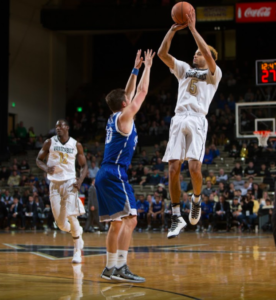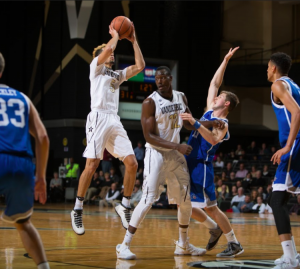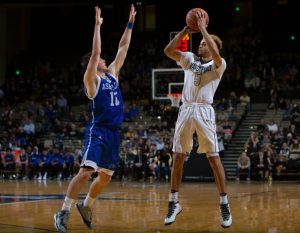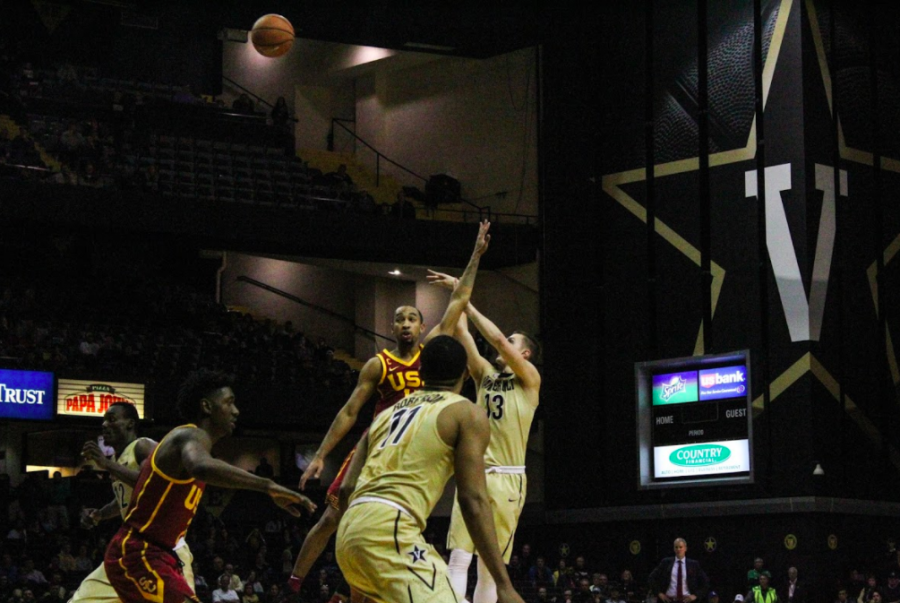“You have to make shots to win basketball games.”
That quote was uttered by one of the greatest basketball coaches of this generation, San Antonio Spurs’ coach Gregg Popovich. Of course, Popovich is known for his dismissive, yet comical responses to interview questions, but he speaks the truth. Basketball is a complicated sport, but at the end of the day, it all boils down to making shots.
That’s why it is so easy to understand why the Vanderbilt Commodores are struggling to win games this season, and why they are looking grossly unimpressive in the games they have won. For a team that prides itself on shooting the basketball, the Commodores have fallen flat this season, missing shots at an alarming rate. This has become most evident over the team’s previous three contests, in which they have shot 23%, 34%, and 42%, respectively.
So how does the team remedy its poor shooting? And can it? Hopefully for Vanderbilt fans, as is often the nature with shooting slumps, the team will break out of it naturally and shots will start to fall. Head coach Bryce Drew still seems optimistic that this will happen, not faulting shot selection.
“If I could go back and write that over, I would take those shots all day,” said Drew after a loss to Seton Hall in which the Commodores shot 0-12 from three in the second half.
For the most part, this is true. On any given day it’s unlikely that Vanderbilt would miss all twelve of those shots, especially given the talent that this team possesses behind the arc. Drew may have diagnosed the problem beyond that.
“That Wilson Solution ball we’ve used three times now and we haven’t shot the ball well in either of those three games, so hopefully we don’t have that ball for a while,” said Drew.
If Drew is right about the basketball, then kudos to him, but all jokes aside, on many occasions, Vanderbilt just isn’t getting good looks. Vanderbilt has never been a team that is going to dominate athletically, and as hard as Jeff Roberson has worked this season to change that narrative, this team isn’t going to bully opponents. What the Commodores have done extremely well in years past is make three-point shots.
Led by the sharpshooting backcourt duo of Riley LaChance and Matthew Fisher-Davis, Vanderbilt accumulated 41.7% of its points last season via the three-ball, the sixth-highest total of any team in the country. This season, however, 29.6% of Vanderbilt’s points come from three-pointers, which ranks 199th in the nation, despite the team taking virtually the same number of shots.
Since at its best, the bulk of this team’s offense comes from outside, it’s important to make those three-point looks good looks. Examples of not-so-good looks from three include shots in motion, shots in transition, and shots forced late into the shot clock, all of which Vanderbilt has fallen victim to throughout the first seven games of this season.
The bulk of that burden falls on the shoulders of Fisher-Davis. The offense has been at its best when he’s shooting the ball well, but it looks lost when he’s in a funk.
Fisher-Davis has an NBA-ready stroke highlighted by a quick release, and he has always possessed the ability to make shots with a defender in his face. The part of his game that has been a struggle is when he shoots on the move, making him unable to set his feet.
In Vanderbilt’s game against UNC-Ashville earlier this season, Fisher-Davis put up 17 points despite a poor shooting night from three, and it’s easy to see why.


 In the first two photos, Fisher-Davis completely fails to set his feet, and as he goes up into the shot, his legs are uneven. With his body twisted and unable to completely face the basket, the shot becomes much more difficult, and both of these shots result in misses. However, on the third shot, even with a hand right in his face, Fisher-Davis squares up to the basket, and has a quick enough release to get the shot off, which he drained.
In the first two photos, Fisher-Davis completely fails to set his feet, and as he goes up into the shot, his legs are uneven. With his body twisted and unable to completely face the basket, the shot becomes much more difficult, and both of these shots result in misses. However, on the third shot, even with a hand right in his face, Fisher-Davis squares up to the basket, and has a quick enough release to get the shot off, which he drained.
This is the most apparent with Fisher-Davis, but so much of the offense’s plight has come from a failure to square up to the basket. Vanderbilt has made a habit of rushing into bad shots instead of creating shots that put its shooters in the best position to make them.
Another reason for these shots is the team’s size, as the Commodores have struggled to score in the lane against bigger defenders. This was most evident against Virginia, where Vanderbilt had several attempts at the rim denied by the Cavalier bigs.
Makes inside are a huge factor in creating an offensive rhythm, and for shooters, just watching the ball go in the net can aid in a shooting slump. The lack of a post presence makes scoring inside increasingly difficult for this team, however, so the points inside have to come in different ways. This is something Vanderbilt didn’t have to worry about as much last year with Luke Kornet in the middle.
“Luke was so unique,” said Drew. “I can’t emphasize enough how much Luke helps other guys get shots on offense.”
Without Kornet, those inside points have to come from guards more, guys who don’t have the size to go up against bigger defenders. In order to create opportunities inside effectively, the Commodores have to unclog the lane, something they failed to do against Virginia. However, against USC, they did this extraordinarily well.

As LaChance drives to the basket here, notice how Djery Baptiste has completely sealed off his defender in the lane, eliminating the help defense that would otherwise likely reject LaChance’s shot. Instead, LaChance is able to blow by Stewart for the bucket and the foul that gave his team the lead late in the second half. Similar play by LaChance and Baptiste was on display against Radford, allowing LaChance to score a career-high 27 points without relying on the three-ball.
To be clear, the Commodores shooting will probably improve naturally. That’s just because of the Law of Percentages, but in order to get to the point where the offense is running like a well-oiled machine, shot selection both inside and out is imperative, and Vanderbilt is struggling to create those shots.
“Our margin of error is really small,” said Drew of his team. “We have to shoot well. I think we’re there but a lot of chips have to fall our way for that to happen.”
A couple tweaks in the offensive gameplan and it won’t just be chips falling for the Commodores.



